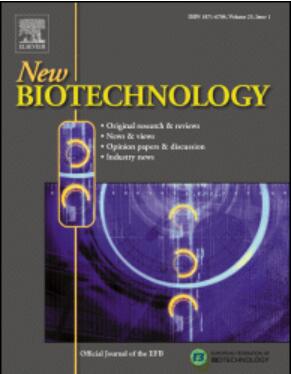海洋硅藻三角藻叶绿体中β-蒎烯的异源生产
IF 4.9
2区 生物学
Q1 BIOCHEMICAL RESEARCH METHODS
引用次数: 0
摘要
微藻被认为是可持续生产植物衍生次生代谢物(如萜类)的有希望的宿主。特别是,模型海洋硅藻褐藻(Phaeodactylum tricornutum)由于其健壮性、相对较快的生长和高的萜类自然积累而成为异种生产这些化学品的有希望的候选者。此外,三角角霉还具有两条独立的萜类前体合成途径,即叶绿体中的MEP途径和细胞质中的MVA途径。在本研究中,我们首次通过在叶绿体和细胞质中单独表达蒎烯合成酶,探索了三角草异源β-蒎烯产生的两条途径。结果表明,epises的叶绿体表达导致β-蒎烯滴度高达10.27 ± 1.45 µg·L−1。未检测到胞质MVA途径前体合成β-蒎烯,但证实了在胞质和叶绿体中蒎烯合成酶的表达和功能。此外,为了提高叶绿体的产量,我们开发了两种不同的蒎烯合成酶基因在染色体上随机整合的更稳定的转基因系。我们观察到,与外生突变体相比,大冷杉(Abies grandis)的蒎烯合成酶滴度高达19.35 ± 1.42 µg·L−1,柑橘柠檬(Citrus limon)的蒎烯合成酶滴度高达20.07 ± 0.51 µg·L−1。本研究使用的所有产β-蒎烯的菌株也产生α-蒎烯作为副产物,占总单萜产量的20-25 %。总的来说,这项研究代表了微藻工程合成单萜类化合物的基本步骤。本文章由计算机程序翻译,如有差异,请以英文原文为准。
Heterologous production of β-pinene in the chloroplast of the marine diatom Phaeodactylum tricornutum
Microalgae are considered promising hosts for the sustainable production of plant-derived secondary metabolites, such as terpenoids. In particular, the model marine diatom Phaeodactylum tricornutum is a promising candidate for the heterologous production of such chemicals due to its robustness, relatively fast growth, and high natural accumulation of terpenoids. In addition, P. tricornutum possesses two separate pathways for the synthesis of terpenoid precursors, the MEP pathway in the chloroplast and the MVA pathway in the cytosol. In this study, we explored the two pathways for the heterologous β-pinene production in P. tricornutum by episomally expressing pinene synthase in either the chloroplast or cytosol for the first time. Our results show that the chloroplast expression from episomes led to β-pinene titers of up to 10.27 ± 1.45 µg·L−1. No β-pinene synthesized from the cytosolic MVA pathway precursors was detected, however the expression and functionality of the pinene synthase was confirmed both in the cytosol and in the chloroplast. Furthermore, to enhance production in the chloroplast, we developed more stable transgenic lines with random chromosomal integration of two different pinene synthase genes. We observed higher titers compared to the episomal mutants, up to 19.35 ± 1.42 µg·L−1 with the pinene synthase from Abies grandis and 20.07 ± 0.51 µg·L−1 with the pinene synthase from Citrus limon. All the β-pinene producing strains used in this study also produced α-pinene as a side product, which accounted for 20–25 % of total monoterpenoid production. Overall, this study represents a fundamental step in microalgal engineering towards the synthesis of monoterpenoids.
求助全文
通过发布文献求助,成功后即可免费获取论文全文。
去求助
来源期刊

New biotechnology
生物-生化研究方法
CiteScore
11.40
自引率
1.90%
发文量
77
审稿时长
1 months
期刊介绍:
New Biotechnology is the official journal of the European Federation of Biotechnology (EFB) and is published bimonthly. It covers both the science of biotechnology and its surrounding political, business and financial milieu. The journal publishes peer-reviewed basic research papers, authoritative reviews, feature articles and opinions in all areas of biotechnology. It reflects the full diversity of current biotechnology science, particularly those advances in research and practice that open opportunities for exploitation of knowledge, commercially or otherwise, together with news, discussion and comment on broader issues of general interest and concern. The outlook is fully international.
The scope of the journal includes the research, industrial and commercial aspects of biotechnology, in areas such as: Healthcare and Pharmaceuticals; Food and Agriculture; Biofuels; Genetic Engineering and Molecular Biology; Genomics and Synthetic Biology; Nanotechnology; Environment and Biodiversity; Biocatalysis; Bioremediation; Process engineering.
 求助内容:
求助内容: 应助结果提醒方式:
应助结果提醒方式:


